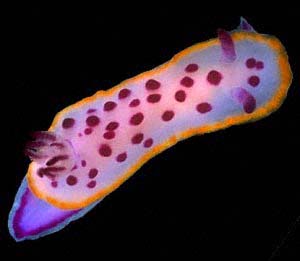
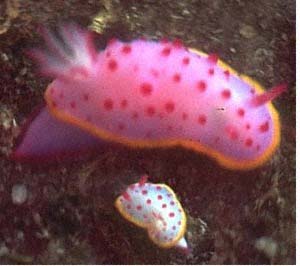
Mexichromis mariei
(Crosse, 1872)
Order: NUDIBRANCHIA
Suborder: DORIDINA
Family: Chromodorididae
DISTRIBUTION
Western Pacific and perhaps Indian Ocean.
PHOTO
UPPER: Nightcliff Reef, Darwin, Northern Territory, Australia, June 1986. PHOTO: Bill Rudman.
LOWER: Malaysia, 1988. PHOTO: Ho Soo Lin
Originally described from New Caledonia, Mexichromis mariei seems to be characterised by the tendency to form reddish purple-tipped rounded papillae on its back. The background colour ranges from translucent white or purple to a deep cream yellow. The mantle border usually consists of a row of orange or yellow spots, but can sometimes be a continuous band. It is similar in colour to Mexichromis festiva but the radular teeth of Mexichromis festiva have many more denticles, and the purple spots are not noticeably raised. I initially (Rudman, 1973, 1983) identified animals from the western Indian Ocean with Mexichromis mariei, but perhaps that species should be considered a distinct species. I have posted it here as Mexichromis cf. mariei. It seems to be consistently different in having bluish purple rather than reddish purple spots. Another species with dorsal papillae, Mexichromis macropus, differs in radular morphology and in having a border of radially arranged orange or yellow lines. See also Mexichromis cf. multituberculata which varies in the colour border and has pointed wine-red tipped tubercles.
References:
• Rudman, W.B. (1973) Chromodorid opisthobranch Mollusca from the Indo-West Pacific. Zoological Journal of the Linnean Society, 52(3): 175-199, 7 figs, 2 col. pl.
• Rudman, W.B. (1983) The Chromodorididae (Opisthobranchia: Mollusca) of the Indo-West Pacific: Chromodoris splendida, C. aspersa and Hypselodoris placida colour groups. Zoological Journal of the Linnean Society, 78: 105-173.
• Rudman, W.B. (1984) The Chromodorididae (Opisthobranchia: Mollusca) of the Indo-West Pacific: a review of the genera. Zoological Journal of the Linnean Society, 81: 115-273.
Rudman, W.B., 1999 (January 16) Mexichromis mariei (Crosse, 1872). [In] Sea Slug Forum. Australian Museum, Sydney. Available from http://www.seaslugforum.net/find/meximari
Related messages
Mating Mexichromis mariei in Bali, Indonesia
August 13, 2007
From: Paul Osmond
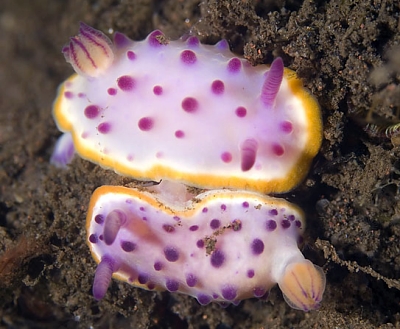
Hi Bill,
Found this pair of Mexichromis mariei mating in the rich ocean floor soil at the Tulamben Slopes dive site in Tulamben Bay in Bali, Indonesia.
Locality: Tulamben Slopes, 10m, Bali, Indonesia, 20 January 2007, Dark Soil, Muck Dive. Length: 30mm. Photographer: Paul T. Osmond.
One of the best dive sites in the world to find a variety of nudibranch species in the rich soil. I was diving with a 105mm macro lens with a +2 diopter and could have gone for more magnification for many of the specimens
Yours,
Paul
www.deepseaimages.com
marriard@deepseaimages.com
Osmond, P.T., 2007 (Aug 13) Mating Mexichromis mariei in Bali, Indonesia. [Message in] Sea Slug Forum. Australian Museum, Sydney. Available from http://www.seaslugforum.net/find/20340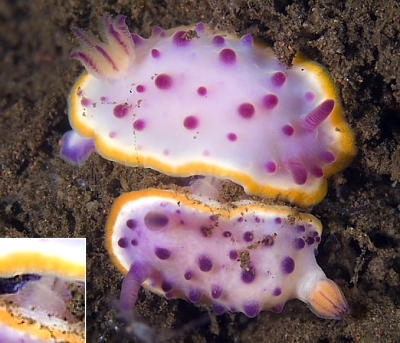
Thanks Paul,
Nice to get purple and a 'red-wine' coloured animals together like this.
Best wishes,
Bill Rudman
Mexichromis mariei? From Izu Hanto, Japan
April 13, 2007
From: Jon Ellis
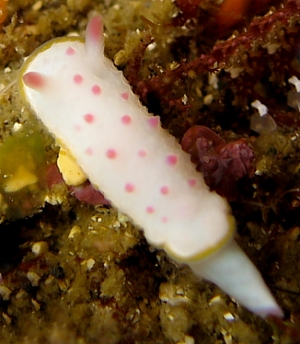
Hi,
Any ideas if this is Mexichromis mariei? It's the only thing that comes close in the reference book...
Locality: Futo Yokobama, 20 m, Izu, Japan, Pacific Ocean, 06 March 2007, Rocky area, at edge of sand plane. Length: 10 mm. Photographer: Jon Ellis.
Thanks!
j.
ashura666@yahoo.com
Ellis, J.J., 2007 (Apr 13) Mexichromis mariei? From Izu Hanto, Japan. [Message in] Sea Slug Forum. Australian Museum, Sydney. Available from http://www.seaslugforum.net/find/19621Dear Jon,
Yes I think this is a juvenile of Mexichromis mariei
Best wishes,
Bill Rudman
Variations in Mexichromis mariei
February 20, 2004
From: Francis and Pirjo Pellet
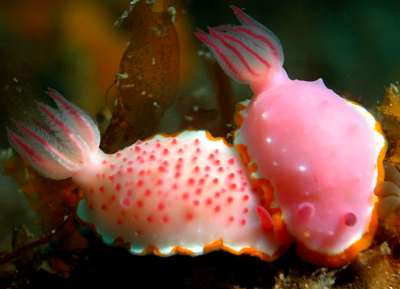
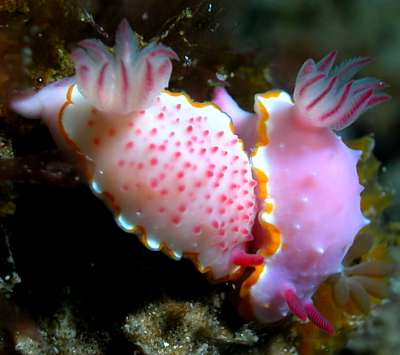
Dear Bill,
Here is a record of Mexichromis mariei from North Sulawesi, Indonesia. They were about 25 mm long and 16m deep. It is interesting to see the variations of the background colour and papillae.
Dive site : Police Pier, Lembeh Strait
Sulawesi Indonesia. 30 September 2003
Best regards
Francis and Pirjo Pellet
pirjo.pellet@free.fr
Pellet, F. &. P., 2004 (Feb 20) Variations in Mexichromis mariei. [Message in] Sea Slug Forum. Australian Museum, Sydney. Available from http://www.seaslugforum.net/find/12233Dear Francis and Pirjo,
Thanks for these photos. I guess being close together doesn't necessarily mean they are the same species, but I strongly suspect they are. This is why I have been hesitant to decide how many 'species' there are in this group, because colour pattern seems to be very variable. Your photo certainly adds strong support for my suggestion that Dong Bum's animals from Sth Korea [#9098] are this species. I suspect they are eating a sponge in your photo but unfortunately it is too covered in growths to identify.
Best wishes
Bill Rudman
Mexichromis mariei? from Japan
February 11, 2004
From: Kunihiro Takahashi
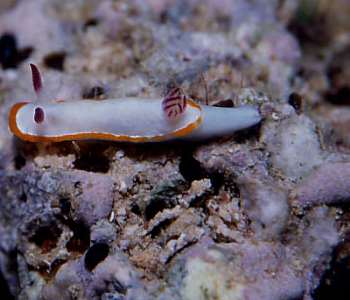
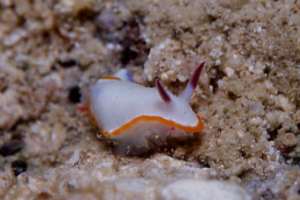
Dear Dr.Rudman
I found this at Okinawa. I think it is Chromodoris rubrocornuta. Could you confirm this please?
Data
Date: 5 May, 2001
Location: Seragaki, Okinawa Japan
Depth: 8m
Length: 8mm
W/Temp: 25C degree
Photo by Kunihiro Takahashi
Best Regards,
Kunihiro Takahashi
manta9216@tontonme.ne.jp
Takahashi, K., 2004 (Feb 11) Mexichromis mariei? from Japan. [Message in] Sea Slug Forum. Australian Museum, Sydney. Available from http://www.seaslugforum.net/find/12157Dear Kunihiro,
This looks a lot like C. rubrocornuta but I am pretty sure this is a colour form, or juvenile, of Mexichromis mariei without the spots. See my earlier discussion [#2811] about this.
Best wishes
Bill Rudman
Mexichromis from Sth Korea
March 26, 2003
From: Dong Bum, Koh
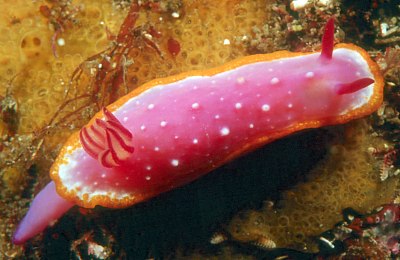
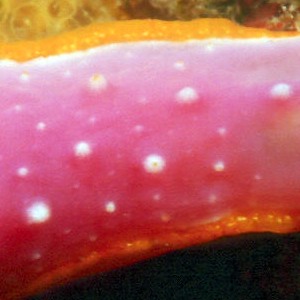
Dear Bill,
I have seen it only one at Sep. 2001., 25m depth in Moon islet, Jeju island. Photo: By Dong Bum, Koh
But I couldn't find it in any books & suspected it as a Chromodoris luteorosea. How about your opinions?
Best regards,
From Dong Bum, Koh
drkoh@seasee.co.kr
Koh, D.B., 2003 (Mar 26) Mexichromis from Sth Korea. [Message in] Sea Slug Forum. Australian Museum, Sydney. Available from http://www.seaslugforum.net/find/9098Dear Dong Bum,
C. luteorosea is a Mediterranean species so it is unlikely to be found in Korea. I am pretty sure your animal is a Mexichromis. As you will have seen on the Forum it is not possible at present to be sure how many species of this genus there are in the Indo-West Pacific. It would seem that quite a lot are colour forms of a single variable species. I am putting yours on the Mexichromis mariei where you will see a wide degree of variation in colour and papillae development.
Best wishes,
Bill Rudman
Re: Noumea subnivalis? from Japan
November 16, 2002
From: Nishina Masayoshi
Dear Bill,
Concerning on my animal from Hachijo Island which I thought might be Noumea subnivalis, I now feel it's more likely to be, as you said, a juvenile Mexichromis than Noumea subnivalis. Especially the the single yellow band on the mantle edge seems to be typical of Mexichromis. From my continuing observation, that single yellow line does not appear on Noumea
subnivalis, even as a juvenile.
Best Regards,
Nishina Masayoshi
nishina@wips.co.jp
Masayoshi, N., 2002 (Nov 16) Re: Noumea subnivalis? from Japan. [Message in] Sea Slug Forum. Australian Museum, Sydney. Available from http://www.seaslugforum.net/find/8408Thanks Nishina,
I have moved the relevant messages to the Mexichromis mariei page.
Best wishes,
Bill Rudman
Mexichromis from Sulawesi
July 16, 2002
From: Mary Jane Adams
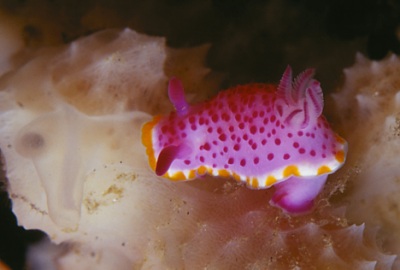
Hi Bill,
After reading your information about the various Mexichromis species, my best guess for this one is Mexichromis mariei. It was 12mm long and about 15 meters deep on a sand slope with patch reef. It looks to me like it has munched away part of this sponge.
Divesite: Police Pier, Lembeh Strait, Sulawesi, Indonesia. April 10, 2002
Best regards,
Mary Jane
divepng@yahoo.com
Adams, M J., 2002 (Jul 16) Mexichromis from Sulawesi. [Message in] Sea Slug Forum. Australian Museum, Sydney. Available from http://www.seaslugforum.net/find/6871Thanks Mary Jane,
The sponge photo is a nice addition to our knowledge, even of we don't know what to call it as yet.
Cheers,
Bill Rudman
Mexichromis mariei? from Japan
April 24, 2002
From: Nishina Masayoshi
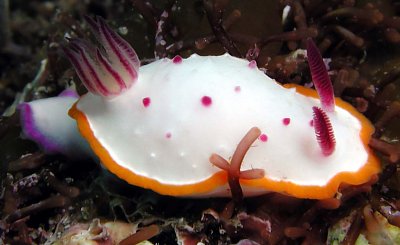
Dear Bill,
From the discussion, I knew that it's bit difficult to tell M. mariei and M. festiva from it exterior features.
This animal dose not look like an animal that I posted before which you identified as
Mexichromis mariei. But I feel this animal is M. mariei, because the reddish-purple spots are not flat or on a slightly rounded bump, they look more like slightly pointed tubercles to me.
Data: Hachijo Island, Japan. 7 April 2002
Length: 20mm., Depth: 10m
Photo by N.Masayoshi
Best Regards,
Nishina Masayoshi
nishina@wips.co.jp
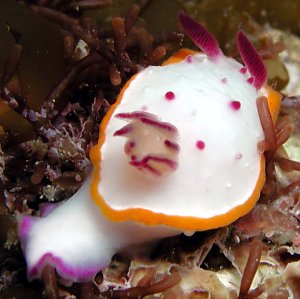
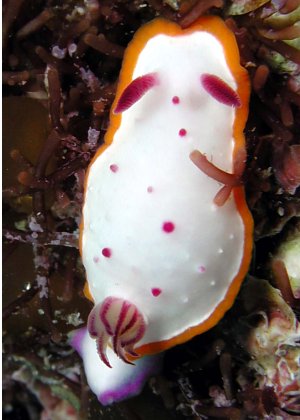
Dear Nishina,
I agree that this seems to fall into the range of variation we are finding in this 'species'. Sone day we will sort them out. There is one interesting feature you can see in the bottom left photo. At the back of the mantle, on the right side you can see a white swelling benath the orange border. In Mexichromis large mantle glands are concentrated at the posterior end of the mantle where they form a group of often prominent swellings on the underside of the mantle edge.
Best wishes,
Bill Rudman.
Mexichromis mariei from Bali
February 24, 2002
From: Stuart Hutchison
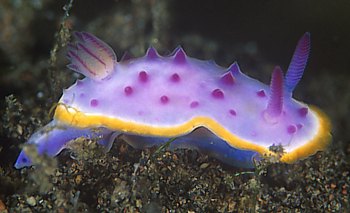
Bill,
Here's Mexichromis mariei from Bali, Indonesia on 24 Oct 2001. Depth 7m, length 40mm. It was the only one we've seen there in 90 dives at the site. Co-incidentally, there were dozens of Mexichromis multituberculata in the general area.
Stuart.
stuart@stuarthutchison.com.au
Hutchison, S., 2002 (Feb 24) Mexichromis mariei from Bali. [Message in] Sea Slug Forum. Australian Museum, Sydney. Available from http://www.seaslugforum.net/find/6278Thanks Stuart,
Bill Rudman
Re: Noumea subnivalis? from Hachijo Id
November 13, 2001
From: Nishina Masayoshi
Dear Dr.Rudman,
Thank you for the meaningful commentary about "Neotony". I've learnt a new word. I didn't exclude the possibility that my animal is a juvenile of Mexichromis, either. However, Mexichromis has reddish gills and rhinophore stalk is rather say whiter. So I suspected that this is may be juvenile of N. subnivalis. But anyway this is too small to tell. I hope I can find N. subnivalis at Hachijo Island too.
Best Regards,
Nishina Masayoshi
nishina@wips.co.jp
Nishina. M., 2001 (Nov 13) Re: Noumea subnivalis? from Hachijo Id. [Message in] Sea Slug Forum. Australian Museum, Sydney. Available from http://www.seaslugforum.net/find/5650Noumea subnivalis? from Japan
November 7, 2001
From: Nishina Masayoshi
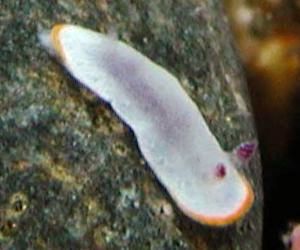
Dear Dr.Rudman,
This animal maybe a kind of Noumea. Perhaps it is a juvenile because of the length (about 2 or 3mm). I think from that discussion we held before about the difference between Noumea nivalis and Noumea subnivalis, it may not be possible to identify these photos.
The color of rhinophore clubs in this animal is deep red with white edging. But the colour band around the mantle margin is single band of yellow or orange color. And the body, perhaps because it is a very small juvenile is not pure white (snow white) with scattered pointed papillae. is it possible for characteristics to appear in juveniles?
If so, there is a high probability that this is the juvenile of Noumea subnivalis.
Location: Hachijo Island Japan, 21 Oct, 2001, Depth: 7m, Length: 2 or 3mm.
Best Regards,
Nishina Masayoshi
nishina@wips.co.jp
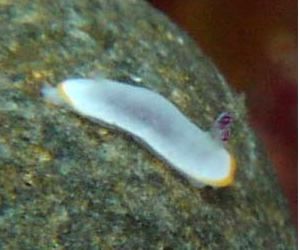
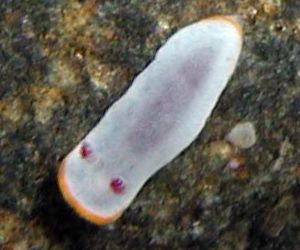
Dear Nishina,
At this size, identification is very difficult. Even if I were to look at their radular teeth I would be unlikely to solve the problem because ther radular of juvenile chromodorids can look quite like the teeth of adult species of Noumea. it is one of the reasons I have suggested in the past that the genus Noumea may have evolved by a process we call neotony. [Neotony is where a juvenile animal becomes sexually mature while still retaining many of its juvenile features].
Another possibility is that your animal is a juvenile Mexichromis [see earlier message]. But basically, I can't disagree with your suggestion that it is probably impossible to identify such small specimens.
Best wishes,
Bill Rudman
Re: Mexichromis from Sagami Bay, Japan
August 11, 2001
From: Nishina Masayoshi
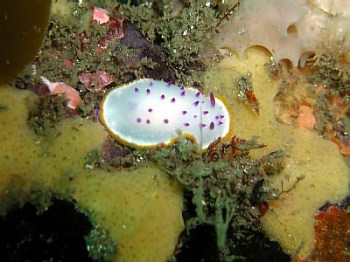
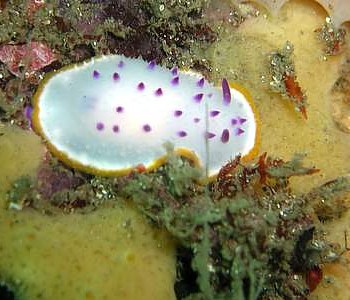
Dear Dr.Rudman,
Thank you very much for your comment on my animal. Before I sent the photo to you, I checked all your comments about Mexichromis on this Forum and etc. As you say, the comment confused me very much.
All my friends said that my animal is Mexichromis festiva. Although we need to see the radular teeth to be sure, I thought it's not Mexichromis festiva from your comment that "the purple spots are not noticeably raised." in M. festiva. I agree that "closely spaced pointed tubercles on the mantle are unusual". It has more pointed tubercles than M. festiva that I can see in photos on other sea slug sites and ID books.
I have attached a photo of the same specimen that I already sent a photo of. It was apparently feeding the yellowish brown sponge at the time.
Best Regards,
Nishina Masayoshi
nishina@hpe15.wips.co.jp
Nishina, M., 2001 (Aug 11) Re: Mexichromis from Sagami Bay, Japan. [Message in] Sea Slug Forum. Australian Museum, Sydney. Available from http://www.seaslugforum.net/find/5036Dear Nishina,
I think it is best to say that we don't know enough about this group of species at present and so any species names we give them are tentative. Mexichromis festiva was first described from New South Wales, Australia, and I have never seen an animal in New South Wales that looks like yours. Perhaps there is one very variable species, but at present we don't know. Thanks very much for the photo with the possible sponge food. In eastern Australia Mexichronis is usually found on a purplish grey sponge, which is probably a Dysidea sp.. Mexichromis festiva has direct development [see egg ribbon photo] so any information on the egg ribbon of your animal would be useful.
When we have taxonomic puzzles like this, where there may be a number of species with variable colour patterns, I think the best thing to do is to have a look at what is happening at a particular location. If we can understand what is happening in a single population then we have a better chance of understanding what is happening in the whole of the Indo-West Pacific. For example, just how much variation do you see? Do your animals always have a continuous orange border or is it sometimes broken into spots? Do you sometimes have animals which have no purple spots? Do your animals always have the pointed tubercles?
Obviously these are not questions you can answer immediately, but they are the type of question which is worth remembering, so that next time these animals are around, you will know what to look our for.
best wishes,
Bill Rudman
Re: Mexichromis from Sagami Bay, Japan
August 11, 2001
From: Bernard Picton
Hi Bill,
Concerning Nishina's Mexichromis from Japan I was looking at Orr's book again, while going through my Hong Kong files. He has a picture identified as Chromodoris festiva (Angas, 1864) which clearly shows a broken yellow line around the margin. Given that a number of warm temperate species do occur both in SW Australia and Hong Kong/Japan I wonder if M. festiva really is present also in the NW Pacific.
Bernard
bernard.picton.um@nics.gov.uk
Picton, B.E., 2001 (Aug 11) Re: Mexichromis from Sagami Bay, Japan. [Message in] Sea Slug Forum. Australian Museum, Sydney. Available from http://www.seaslugforum.net/find/5038Dear Bernard,
John Orr's photo certainly has similarities to both M. festiva and M. mariei. I certainly have no objections to a species from New South Wales also occurring in the NE Pacific. Interestingly I suspect the apparent disjunct distribution which seemed to exist between southeastern temperate Australia and Japan for a number of species, including Kaloplocamus acutus, Hypselodoris maritima, Stilger smaragdinus, Sagaminopteron ornata etc, is now being shown to represent a disjunct distribution of opisthobranch workers. As more collecting takes place in the tropical regions in between, the distribution gaps seem to be disappearing.
Cheers,
Bill Rudman
Mexichromis from Sagami Bay, Japan
August 8, 2001
From: Nishina Masayoshi
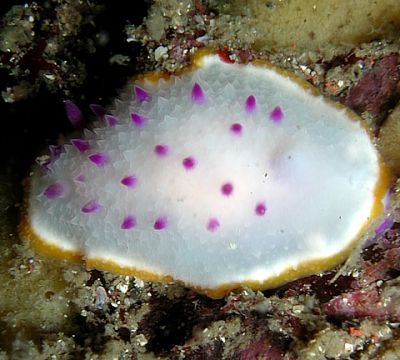
Dear Dr.Rudman,
Here is a photo of Mexichromis that Chikako took on 7th July, 2001 at Enoura beach, Sagami Bay, Japan.
Depth: 5m
Size: 25mm
Comment: Rare here, but confirmed that Mexichromis festiva is here.
Best Regards,
Nishina Masayoshi
nishina@hpe15.wips.co.jp
Nishina, M., 2001 (Aug 8) Mexichromis from Sagami Bay, Japan. [Message in] Sea Slug Forum. Australian Museum, Sydney. Available from http://www.seaslugforum.net/find/4940Dear Nishina,
If you look at my comments on the various species of Mexichromis on the Forum you will see that we are still a bit confused about the species of this group.
Your animal is clearly the same as the one that Baba (1989) identified as Mexichromis festiva but it is quite unlike typical M. festiva from Sydney Harbour, which lacks the pointed tubercles o the mantle and has a mantle margin consistig of a series of elongate spots rather than an entire line. I think the best place for your photo at the moment is Mexichromis mariei but the closely spaced pointed tubercles on the mantle are unusual. Any information and photos of the sponge it feeds on and its egg ribbon would be very valuable.
• Baba, K (1989): More study on two species of Mexichromis from Japan (Nudibranchia: Chromodorididae). Venus, The Japanese Journal of Malacology, 48(1): 12-20.
Best wishes,
Bill Rudman.
Chromodoris? or Mexichromis sp from Okinawa
August 4, 2000
From: Kazuko Matsuda
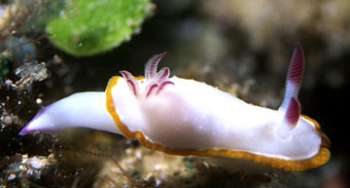
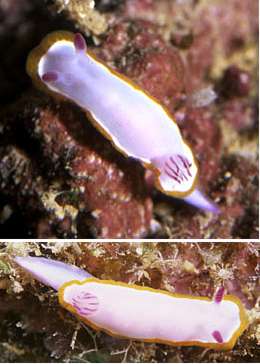
Dear Bill
These animals were found at Sunabe in Okinawa, Japan. They are similar to an animal you call Chromodoris? sp. 12 which was found at Kerama Is. near Okinawa.
The animal in the upper photo is 15mm long, and there are small tubercles (I don't know this is a proper word) on its mantle. The middle one is smaller, 11mm long, and its mantle is smooth. The lower one is the biggest of the three, 17mm long, and it has small tubercles on its mantle like the first one. I'm afraid that you cannot see them , because the photo is out of focus.
Are they Chromodoris sp.? They also look like Mexichromis sp. though.
Data:
Upper photo: 3 June 2000, 15mm long, 20m depth
Middle photo: 15 July 2000, 11mm long, 15m depth
Lower photo: 21 May 2000, 17mm long, 13m depth
Sincerely,
Kazuko Matsuda
matsu@ii-okinawa.ne.jp
Matsuda, K., 2000 (Aug 4) Chromodoris? or Mexichromis sp from Okinawa. [Message in] Sea Slug Forum. Australian Museum, Sydney. Available from http://www.seaslugforum.net/find/2811Dear Kasuko,
I am sorry but I think a Chromodoris sp. 12 page must have stayed in the Forum, long after I decided it was a Mexichromis. The page has now disappeared because we are at present correcting little errors and lost files that we have found while moving the Forum to its new home at www.seaslugforum.net
Your photos are very interesting as they show both smooth and tuberculate forms of what is clearly the same animal. If you have a look at the photos from Mike Miller, Bob Bolland and Atsushi Ono you will see that there is a range from smooth unspotted animals to tuberculate purple-spotted animals.
At present I have decided to put them all together on the Mexichromis mariei page, though of course we would need to look at their anatomy to be sure.
Best wishes,
Bill Rudman.
An unspotted Mexichromis? from Kerama Is
July 22, 2000
From: Atsushi Ono
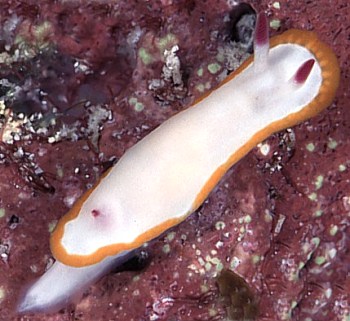
Dear Bill
I found another chromodorid species that is similar to Mexichromis mariei at Kerama Is. near Okinawa, Japan.
It is 10mm long, found at 5m depth on a coral reef in Nov. 1999 at Kerama Is. near Okinawa in Japan.
This is very rare species, I have only found a single individual.
Could you help me to identify this?
Sincerely,
Atsushi Ono
ononini@cosmos.ne.jp
Ono, A. , 2000 (Jul 22) An unspotted Mexichromis? from Kerama Is. [Message in] Sea Slug Forum. Australian Museum, Sydney. Available from http://www.seaslugforum.net/find/2469Dear Atsushi,
Your animal certainly looks like the Mike Miller's photo of an animal from Indonesia, with only a slight trace of spots. Even the trace of a submarginal purple border to the foot fits Mexichromis.
There are a large number of white chromodorids with a yellow or orange border but your animal doesn't match any of them.
The only way to be sure would be to study its anatomy, but I would certainly agree that apart from the missing spots, it looks like Mexichromis mariei.
Best wishes,
Bill Rudman.
Mexichromis sp. from Okinawa
December 23, 1999
From: Robert F. Bolland
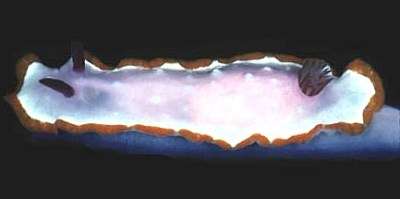
Hi Bill:
Here is an Okinawan Mexichromis of unknown status. I've found several of these which look to be similar to each other. Any idea as to the species?
Collection Data: RFB # 2486-E
Beneath Tengan Pier, amid rubble and silty-sand, 12m. TL: 29mm. 8 March, 1991
Wishing you and the staff of the Australian Museum a Merry Christmas and a Happy New Year!
Sincerely,
Bob
bollandr@rapid-link.ne.jp
Bolland, R.F., 1999 (Dec 23) Mexichromis sp. from Okinawa. [Message in] Sea Slug Forum. Australian Museum, Sydney. Available from http://www.seaslugforum.net/find/1709Dear Bob,
Thanks for the photo, I'm afraid I can't help with an id.
Thanks for the season's greetings which I will pass on. Thanks also for your participation during the year and I look forward to future contributions.
Best wishes,
Bill Rudman.
[Note added August 2000: I previously had this listed as Mexichromis sp. 1. ...Bill Rudman]
Re: The Mexichromis mariei story
January 20, 1999
From: Mike Miller
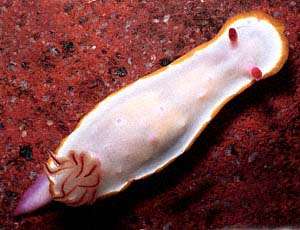
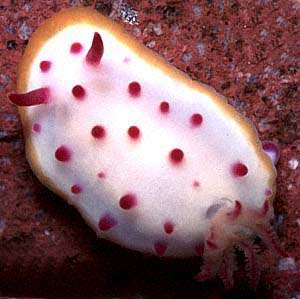
Dear Bill
To further muddy the waters regarding recent Mexichromis submissions, you will find attached two (2) images of what is believed to be Mexichromis mariei based on your recent postings. Both Images were also taken at Tulamblen, Bali, Indonesia in the general area where the previous pics of Mexichromis cf. multituberculata were recorded. Limited development of the wine-red tipped tubercles are evident in one specimen. Any idea as to what is going on here???
Cheers;
Mike Miller
mdmiller@cts.com
Miller, M.D., 1999 (Jan 20) Re: The Mexichromis mariei story. [Message in] Sea Slug Forum. Australian Museum, Sydney. Available from http://www.seaslugforum.net/find/498Dear Mike,
Thanks for the pics. The low rounded pustules seem to be a feature of what I think is M. mariei. Another feature, which your photos reinforce, is that this species has a solid orange border to the mantle. I know someone will probably send a photo now to prove me wrong but that's the value of the Forum... a chance to informally swap ideas and images. Certainly your original images have caused me to rethink my earlier ideas on this group of Mexichromis and it helps to make sense of the anatomical and radular differences I have found.
Bill Rudman.
